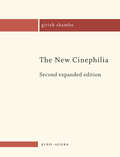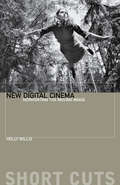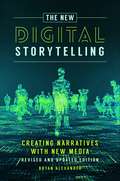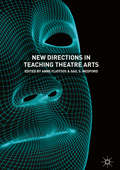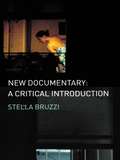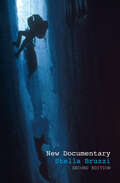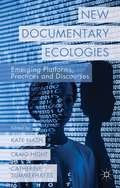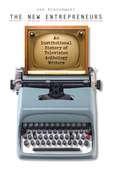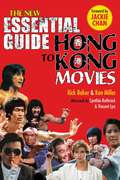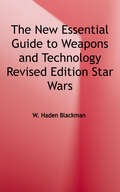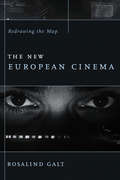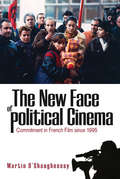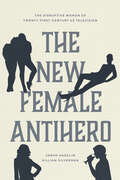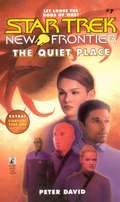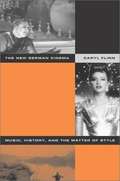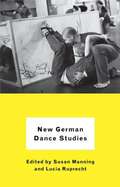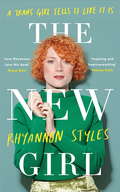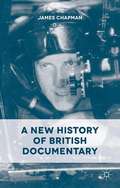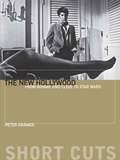- Table View
- List View
The New Cinephilia
by Girish ShambuCinephilia has recently experienced a powerful resurgence, one enabled by new media technologies of the digital revolution. One strong continuity between today's "new cinephilia" and the classical cinephilia of the 1950s is the robust sociability which these new technologies have facilitated. Each activity of today's cinephilic practice – viewing, thinking, reading and writing about films – is marked by an unprecedented amount of social interaction facilitated by the Internet. As with their classical counterparts, the thoughts and writings of today's cinephiles are born from a vigorous and broad-ranging cinephilic conversation. Further, by dramatically lowering the economic barriers to publication, the Internet has also made possible new hybrid forms and outlets of cinephilic writing that draw freely from scholarly, journalistic and literary models. This book both describes and theorises how and where cinephilia lives and thrives today. In this expanded second edition, the author revisits some of his original ideas and calls into question the focus in cinephilia on the male canon in the wake of the #MeToo movement and the lack of racial and gender diversity in contemporary cinema. "There is more to the cinephile experience than simply surfing from one link to another in a state of perpetual motion. How does this movement – this daily proliferation of encounters – power one's cinephilia? What special affective charge does this experience hold? In other words, how is the experience of the Internet cinephile affectively different from that of a 'traditional' cinephile who spends little time online?" — Girish Shambu
New Digital Cinema: Reinventing the Moving Image (Short Cuts)
by Holly WillisThis introduction to contemporary digital cinema tracks its intersection with video art, music video, animation, print design and live club events to create an avant-garde for the new millennium. It begins by investigating digital cinema and its contribution to innovations in the feature-film format, examining animation and live-action hybrids, the gritty aesthetic of the Dogme 95 filmmakers, the explosions of frames within frames and the evolution of the ‘ambient narrative’ film. This study then looks at the creation of new genres and moving-image experiences as what we know as ‘cinema’ enters new venues and formats.
The New Digital Storytelling: Creating Narratives With New Media
by Bryan AlexanderWritten for everyone interested in the communication potential of digital media, including educators, marketers, communication professionals, and community activists, this is the ultimate guide to harnessing technology for storytelling. No other book covers the digital storytelling movement as thoroughly as this updated second edition of a popular work, nor does any incorporate as many technologies, from video to augmented reality, mobile devices to virtual reality. <p><p> The book combines history, analysis, and practical guidance about digital storytelling. It begins with a history that encompasses an exploration of storytelling itself, as well as a description of narratives using digital tools from the 1980s through 2000. From there, the author dives into modern digital storytelling, offering analysis and guidance regarding the use of digital video, podcasting, social media, gaming, mobile devices, and virtual and augmented reality. The work concludes with practical advice about how to create and share digital stories using the most current tools so even the new would-be storyteller can create their first digital narrative. <p> Of course, the second edition is updated to take into account the many ways the field has advanced since the original book appeared. With many new examples of digital stories, this edition's evidence base is current and fresh. New or transformed technologies are also addressed, including virtual reality; mobile devices that have become mainstream tools for creating, sharing, and experiencing digital stories; and the wide variety of new storytelling apps and services.
New Directions in Teaching Theatre Arts
by Anne Fliotsos Gail S. MedfordThis book reflects the changes in technology and educational trends (cross-disciplinary learning, entrepreneurship, first-year learning programs, critical writing requirements, course assessment, among others) that have pushed theatre educators to innovate, question, and experiment with new teaching strategies. The text focuses upon a firm practice-based approach that also reflects research in the field, offering innovative and proven methods that theatre educators may use to actively engage students and encourage student success. The sixteen essays in this volume are divided into five sections: Teaching with Digital Technology, Teaching in Response to Educational Trends, Teaching New Directions in Performance, Teaching Beyond the Traditional, and Teaching Collaboratively or Across Disciplines. Study of this book will provoke readers to question both teaching methods and curricula as they consider the ever-shifting arts landscape and the potential careers for theatre graduates.
New Documentaries in Latin America
by Vinicius Navarro Juan Carlos Rodr�guezExamining the vast breadth and diversity of contemporary documentary production, while also situating nonfiction film and video within the cultural, political, and socio-economic history of the region, this book addresses topics such as documentary aesthetics, indigenous media, and transnational filmmaking, among others.
New Documentary: A Critical Introduction
by Stella BruzziNew Documentary: A Critical Introduction provides a comprehensive account of the last two decades of documentary filmmaking in Britain, the US and Europe. Stella Bruzzi's engaging textbook discusses key genres, filmmakers, and issues for the study of non-fiction film and television, including:* key texts such as the Zapruder film of Kennedy's assassination, Shoah, Hoop Dreams and Michael Apted's 7 Up series* documentary genres, from current affairs programming to 'fly on the wall' documentaries to 'reality tv' series* the work of documentary filmmakers such as Emile de Antonio, Fred Wiseman, Nick Broomfield, Molly Dineen and Paul Watson* the work of avant-garde filmmakers such as Chris Marker, Patrick Keiller, Peter Greenaway and Wim Wenders, whose films challenge conventions of documentary filmmaking* movies based on historical events, such as 'JFK' and 'Nixon'* faux documentaries such as This is Spinal Tap, Bob Roberts and Man Bites Dog* gender identity, queer theory, performance, 'race' and spectatorship.Bruzzi shows how theories of documentary filmmaking can be applied to contemporary texts and genres, and discusses the relationship between recent, innovative examples of the genre and the more established canon of documentary.
New Documentary
by Stella BruzziPraise for New Documentary: 'It's refreshing to find a book that cuts through the tired old debates that have surrounded documentary film and television. It heralds a welcome new approach.' Sight and Sound 'Documentary practice changes so fast that books on the subject are often out of date before they are published. Bruzzi's achievement is to have understood the genre as an activity based on performance rather than observation. This is a fresh perspective which illuminates the fundamental shifts that will continue to take place in the genre as it enters its second century.' John Ellis, Professor of Media Arts, Royal Holloway, University of LondonNew Documentary provides a contemporary look at documentary and fresh and challenging ways of theorising the non-fiction film. As engaging as the original, this second edition features thorough updates to the existing chapters, as well as a brand new chapter on contemporary cinema release documentaries. This new edition includes: Contemporary films such as Capturing the Friedmans, Être et avoir, Farenheit 9/11, The Fog of War and Touching the Void as well as more canonical texts such as Hoop Dreams and Shoah Additional interviews with influential practitioners, such as director Michael Apted and producer Stephen Lambert A comprehensively revised discussion of modern observational documentary, including docusoaps, reality television and formatted documentaries The work of documentary filmmakers such as Nicholas Barker, Errol Morris, Nick Broomfield, Molly Dineen and Michael Moore and the work of Avant-Garde filmmakers such as Chris Marker and Patrick Keiller Gender identity, queer theory, performance, race and spectatorship. Bruzzi shows how theories of documentary filmmaking can be applied to contemporary texts and genres, and discusses the relationship between recent, innovative examples of the genre and the more established canon of documentary.
New Documentary Ecologies
by Kate Nash Craig Hight Catherine SummerhayesProviding a unique collection of perspectives on the persistence of documentary as a vital and dynamic media form within a digital world, New Documentary Ecologies traces this form through new opportunities of creating media, new platforms of distribution and new ways for audiences to engage with the real.
The New Entrepreneurs
by Jon KraszewskiAccording to the sociologist C. Wright Mills in his 1951 book, White Collar: The American Middle Classes, the "new entrepreneur" was a lone wolf able to succeed in post-World War II corporate America by elusively meandering through various institutions. During this time, anthology writers such as Rod Serling, Reginald Rose, and Paddy Chayefsky achieved a level of creativity that has rarely been equaled on television since. Yet despite their success, anthology writers still needed to evade the constraints and censorship of 50s television in order to stay true to their creative powers and political visions. Thus they worked as new entrepreneurs who adapted their more controversial scripts for the Hollywood, Broadway, and book publishing industries. Even after the television networks cancelled their prestigious anthology series at the end of the 50s, the most resilient writers were able to redefine what it meant to be entrepreneurs by launching cutting-edge shows such as The Twilight Zone and The Defenders that are still popular today. The New Entrepreneurs includes detailed textual analysis of legendary, sometimes hard-to-find, television anthology scripts that have received only cursory glances in television history until now.
New Essential Guide to Hong Kong Movies
by Rick Baker Kenneth MillerExtensively revised and expanded, The New Essential Guide to Hong Kong Movies includes over 670 film reviews, a poster gallery, and a look at the key studios that made Hong Kong cinema so amazing, along with insights into the Hong Kong movie industry written by global superstar Jackie Chan and Hong Kong film stars Cynthia Rothrock, and Vincent Lyn. Rick Baker and Ken Miller have curated a huge selection of reviews of kung fu and swordplay films, gangster flicks, crime dramas, action, horror, fantasy, erotic, and assorted Category III films, sharing their love for these distinctive, kinetic, and sometimes utterly bizarre Hong Kong genre productions with an infectious enthusiasm.
The New Essential Guide to Weapons and Technology Revised Edition Star Wars
by W. Haden BlackmanFrom the Geonosian sonic blaster to the Wookiee bowcaster; from the Imperial energy grenade to the Yuuzhan Vong fire spitter; from dart shooters and laser cannons to Sun Crushers and World Devastators, find the facts about Star Wars firepower--and much more--in The New Essential Guide to Weapons + Technology. There's more to the arms, artillery, and exotic equipment of the Star Wars galaxy than Jedi lightsabers and blasters. Species such as the tree-dwelling Wookiees, the amphibious Gungans, and the deadly Yuuzhan Vong have yielded a staggering array of unique weapons and devices. And as the Star Wars mythos continues to grow--in prequels and video games, on screen, in print, and beyond--these remarkable technical creations also multiply and evolve. The New Essential Guide to Weapons + Technology is the fully updated and greatly expanded reference resource that organizes and explains every key class, make, and model of Star Wars munitions--from the smallest personal sidearms to the most devastating interplanetary superweapons--along with a host of other high-tech paraphernalia. This exhaustive compendium includes:- New in this edition: A fascinating look at the historical significance of Star Wars weaponry and the major technological turning points--including the Clone Wars, the creation of the first Death Star, and the Yuuzhan Vong invasion - A roster of the major manufacturers who created the most powerful armaments for the Old and New Republics, the Empire, the Sith, the Rebel Alliance, andall of the exotic governments that populate the Star Wars galaxy - In-depth descriptions of more than 100 weapons and more than 100 additional devices used for defense, communication, survival, and security--including key technology featured in the films
The New European Cinema: Redrawing the Map (Film and Culture Series)
by Rosalind GaltNew European Cinema offers a compelling response to the changing cultural shapes of Europe, charting political, aesthetic, and historical developments through innovative readings of some of the most popular and influential European films of the 1990s. Made around the time of the revolutions of 1989 but set in post-World War II Europe, these films grapple with the reunification of Germany, the disintegration of the Balkans, and a growing sense of historical loss and disenchantment felt across the continent. They represent a period in which national borders became blurred and the events of the mid-twentieth-century began to be reinterpreted from a multinational European perspective.Featuring in-depth case studies of films from Italy, Germany, eastern Europe, and Scandinavia, Rosalind Galt reassesses the role that nostalgia, melodrama, and spectacle play in staging history. She analyzes Giuseppe Tornatore's Cinema Paradiso, Michael Radford's Il Postino, Gabriele Salvatores's Mediterraneo, Emir Kusturica's Underground, and Lars von Trier's Zentropa, and contrasts them with films of the immediate postwar era, including the neorealist films of Roberto Rossellini and Vittorio De Sica, socialist realist cinema in Yugoslavia, Billy Wilder's A Foreign Affair, and Carol Reed's The Third Man. Going beyond the conventional focus on national cinemas and heritage, Galt's transnational approach provides an account of how post-Berlin Wall European cinema inventively rethought the identities, ideologies, image, and popular memory of the continent. By connecting these films to political and philosophical debates on the future of Europe, as well as to contemporary critical and cultural theories, Galt redraws the map of European cinema.
The New Face Of Political Cinema
by Martin OashaughnessySince 1995 there has been a widespread return of commitment to French cinema taking it to a level unmatched since the heady days following 1968. But this new wave of political film is very different and urgently calls out for an analysis that will account for its development, its formal characteristics and its originality. This is what this book provides. It engages with leading directors such as Cantet, Tavernier, Dumont, Kassovitz, Zonca and Guédiguian, takes in a range of less well known but important figures and strays across the Belgian border to engage with the seminal work of the Dardenne brothers. It shows how the works discussed are helping to reinvent political cinema by finding stylistic and narrative strategies adequate to the contemporary context.
The New Female Antihero: The Disruptive Women of Twenty-First-Century US Television
by Sarah Hagelin Gillian SilvermanThe New Female Antihero examines the hard-edged spies, ruthless queens, and entitled slackers of twenty-first-century television. The last ten years have seen a shift in television storytelling toward increasingly complex storylines and characters. In this study, Sarah Hagelin and Gillian Silverman zoom in on a key figure in this transformation: the archetype of the female antihero. Far from the sunny, sincere, plucky persona once demanded of female characters, the new female antihero is often selfish and deeply unlikeable. In this entertaining and insightful study, Hagelin and Silverman explore the meanings of this profound change in the role of women characters. In the dramas of the new millennium, they show, the female antihero is ambitious, conniving, even murderous; in comedies, she is self-centered, self-sabotaging, and anti-aspirational. Across genres, these female protagonists eschew the part of good girl or role model. In their rejection of social responsibility, female antiheroes thus represent a more profound threat to the status quo than do their male counterparts. From the devious schemers of Game of Thrones, The Americans, Scandal, and Homeland, to the joyful failures of Girls, Broad City, Insecure, and SMILF, female antiheroes register a deep ambivalence about the promises of liberal feminism. They push back against the myth of the modern-day super-woman—she who “has it all”—and in so doing, they give us new ways of imagining women’s lives in contemporary America.
The New Female Antihero: The Disruptive Women of Twenty-First-Century US Television
by Sarah Hagelin Gillian SilvermanThe New Female Antihero examines the hard-edged spies, ruthless queens, and entitled slackers of twenty-first-century television. The last ten years have seen a shift in television storytelling toward increasingly complex storylines and characters. In this study, Sarah Hagelin and Gillian Silverman zoom in on a key figure in this transformation: the archetype of the female antihero. Far from the sunny, sincere, plucky persona once demanded of female characters, the new female antihero is often selfish and deeply unlikeable. In this entertaining and insightful study, Hagelin and Silverman explore the meanings of this profound change in the role of women characters. In the dramas of the new millennium, they show, the female antihero is ambitious, conniving, even murderous; in comedies, she is self-centered, self-sabotaging, and anti-aspirational. Across genres, these female protagonists eschew the part of good girl or role model. In their rejection of social responsibility, female antiheroes thus represent a more profound threat to the status quo than do their male counterparts. From the devious schemers of Game of Thrones, The Americans, Scandal, and Homeland, to the joyful failures of Girls, Broad City, Insecure, and SMILF, female antiheroes register a deep ambivalence about the promises of liberal feminism. They push back against the myth of the modern-day super-woman—she who “has it all”—and in so doing, they give us new ways of imagining women’s lives in contemporary America.
The New Female Antihero: The Disruptive Women of Twenty-First-Century US Television
by Sarah Hagelin Gillian SilvermanThe New Female Antihero examines the hard-edged spies, ruthless queens, and entitled slackers of twenty-first-century television. The last ten years have seen a shift in television storytelling toward increasingly complex storylines and characters. In this study, Sarah Hagelin and Gillian Silverman zoom in on a key figure in this transformation: the archetype of the female antihero. Far from the sunny, sincere, plucky persona once demanded of female characters, the new female antihero is often selfish and deeply unlikeable. In this entertaining and insightful study, Hagelin and Silverman explore the meanings of this profound change in the role of women characters. In the dramas of the new millennium, they show, the female antihero is ambitious, conniving, even murderous; in comedies, she is self-centered, self-sabotaging, and anti-aspirational. Across genres, these female protagonists eschew the part of good girl or role model. In their rejection of social responsibility, female antiheroes thus represent a more profound threat to the status quo than do their male counterparts. From the devious schemers of Game of Thrones, The Americans, Scandal, and Homeland, to the joyful failures of Girls, Broad City, Insecure, and SMILF, female antiheroes register a deep ambivalence about the promises of liberal feminism. They push back against the myth of the modern-day super-woman—she who “has it all”—and in so doing, they give us new ways of imagining women’s lives in contemporary America.
New Frontier #7 The Quiet Place (Star Trek: The Next Generation #Bk.7)
by Peter DavidEver since the fall of the Thallonian Empire, Si Cwan has been searching for his younger sister, the only other survivor of the royal family. Now it seems his quest may be nearing its end. On the planet Montos a mysterious young woman, her past shrouded in secrecy, finds herself pursued both by the fanatical Redeemers and a vicious race of feral predators known only as the Dogs of War. All are after information regarding the true nature and location of the Quiet Place, a mystical realm celebrated in myth and legend. Is Riella indeed Si Cwan's long-lost sister? Before he can learn the truth, he and his companions - Mackenzie Calhoun, the scarred, alien captain recommended by Jean-Luc Picard; Commander Shelby, ambitious first officer and Calhoun's fomer lover; Dr Selar, the Vulcan physician formerly assigned to the Enterprise; Ops officer Robin Lefler, and the rest of the Excalibur's crew - must brave the unchecked savagery of the Dogs of War - and enter the terrifying heart of the Quiet Place.
The New German Cinema: Music, History, and the Matter of Style
by Caryl FlinnWhen New German cinema directors like R. W. Fassbinder, Ulrike Ottinger, and Werner Schroeter explored issues of identity--national, political, personal, and sexual--music and film style played crucial roles. Most studies of the celebrated film movement, however, have sidestepped the role of music, a curious oversight given its importance to German culture and nation formation. Caryl Flinn's study reverses this trend, identifying styles of historical remembrance in which music participates. Flinn concentrates on those styles that urge listeners to interact with difference--including that embodied in Germany's difficult history--rather than to "master" or "get past" it. Flinn breaks new ground by considering contemporary reception frameworks of the New German Cinema, a generation after its end. She discusses transnational, cultural, and historical contexts as well as the sexual, ethnic, national, and historical diversity of audiences. Through detailed case studies, she shows how music helps filmgoers engage with a range of historical subjects and experiences. Each chapter ofThe New German Cinemaexamines a particular stylistic strategy, assessing music's role in each. The study also examines queer strategies like kitsch and camp and explores the movement's charged construction of human bodies on which issues of ruination, survival, memory, and pleasure are played out.
New German Dance Studies
by Lucia Ruprecht Susan ManningNew German Dance Studies offers fresh histories and theoretical inquiries that resonate across fields of the humanities. Sixteen essays range from eighteenth-century theater dance to popular contemporary dances in global circulation. In an exquisite trans-Atlantic dialogue that demonstrates the complexity and multilayered history of German dance, American and European scholars and artists elaborate on definitive performers and choreography, focusing on three major thematic areas: Weimar culture and its afterlife, the German Democratic Republic, and recent conceptual trends in theater dance. Contributors are Maaike Bleeker, Franz Anton Cramer, Kate Elswit, Susanne Franco, Susan Funkenstein, Jens Richard Giersdorf, Yvonne Hardt, Sabine Huschka, Claudia Jeschke, Marion Kant, Gabriele Klein, Karen Mozingo, Tresa Randall, Gerald Siegmund, and Christina Thurner.
The New Girl: A Trans Girl Tells It Like It Is
by Rhyannon Styles'Inspiring and heart-wrenching' Paloma Faith 'Love Rhyannon. Love this book' Grace Dent The remarkable transgender memoir you won't stop hearing about. Rhyannon Styles will do for transgender what Matt Haig did for mental health. Elle columnist Rhyannon Styles tells her unforgettable life story in THE NEW GIRL, reflecting on her past and charting her incredible journey from male to female. A raw, frank and utterly moving celebration of life.Imagine feeling lost in your own body. Imagine spending years living a lie, denying what makes you 'you'. This was Ryan's reality. He had to choose: die as a man or live as a woman.In 2012, Ryan chose Rhyannon. At the age of thirty she began her transition, taking the first steps on the long road to her true self.Rhyannon holds nothing back in THE NEW GIRL, a heartbreakingly honest telling of her life. Through her catastrophic lows and incredible highs, she paints a glorious technicolour picture of what it's like to be transgender. From cabaret drag acts, brushes with celebrity and Parisian clown school, to struggles with addiction and crippling depression, Rhyannon's story is like nothing you've read before.Narrated with searing honesty, humour and poignancy, THE NEW GIRL is a powerful book about being true to ourselves, for anyone who's ever felt a little lost.
The New Girl: A Trans Girl Tells It Like It Is
by Rhyannon Styles'Inspiring and heart-wrenching' Paloma Faith 'Love Rhyannon. Love this book' Grace Dent The remarkable transgender memoir you won't stop hearing about. Rhyannon Styles will do for transgender what Matt Haig did for mental health. Elle columnist Rhyannon Styles tells her unforgettable life story in THE NEW GIRL, reflecting on her past and charting her incredible journey from male to female. A raw, frank and utterly moving celebration of life.Imagine feeling lost in your own body. Imagine spending years living a lie, denying what makes you 'you'. This was Ryan's reality. He had to choose: die as a man or live as a woman.In 2012, Ryan chose Rhyannon. At the age of thirty she began her transition, taking the first steps on the long road to her true self.Rhyannon holds nothing back in THE NEW GIRL, a heartbreakingly honest telling of her life. Through her catastrophic lows and incredible highs, she paints a glorious technicolour picture of what it's like to be transgender. From cabaret drag acts, brushes with celebrity and Parisian clown school, to struggles with addiction and crippling depression, Rhyannon's story is like nothing you've read before.Narrated with searing honesty, humour and poignancy, THE NEW GIRL is a powerful book about being true to ourselves, for anyone who's ever felt a little lost.
The New Grove: Handel
by Winton DeanBiography of George Frederick Handel, including a comprehensive worklist and bibliography, in addition to the definitive view of Handel's life and works.
The New Grove: Haydn
by Jens Peter LarsenBiography of Franz Joseph Haydn, including a comprehensive worklist and bibliography, in addition to the definitive view of Haydn's life and works.
A New History of British Documentary
by James ChapmanA New History of British Documentary is the first comprehensive overview of documentary production in Britain from early film to the present day. It covers both the film and television industries and demonstrates how documentary practice has adapted to changing institutional and ideological contexts.
The New Hollywood: From Bonnie and Clyde to Star Wars (Short Cuts)
by Peter KrämerOn December 8, 1967 Time magazine put Bonnie and Clyde on its cover and announced, "The New Cinema: Violence ... Sex ... Art." The following decade has long been celebrated as a golden age in American film history. In this innovative study, Peter Krämer offers a systematic discussion of the biggest hits of the period (including The Graduate [1967], The Exorcist [1973] and Jaws [1975]). He relates the distinctive features of these hits to changes in the film industry, in its audiences and in American society at large.
